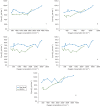Systemic oxygen extraction during exercise at high altitude
- PMID: 25501722
- PMCID: PMC4364061
- DOI: 10.1093/bja/aeu404
Systemic oxygen extraction during exercise at high altitude
Abstract
Background: Classic teaching suggests that diminished availability of oxygen leads to increased tissue oxygen extraction yet evidence to support this notion in the context of hypoxaemia, as opposed to anaemia or cardiac failure, is limited.
Methods: At 75 m above sea level, and after 7-8 days of acclimatization to 4559 m, systemic oxygen extraction [C(a-v)O2] was calculated in five participants at rest and at peak exercise. Absolute [C(a-v)O2] was calculated by subtracting central venous oxygen content (CcvO2) from arterial oxygen content [Formula: see text] in blood sampled from central venous and peripheral arterial catheters, respectively. Oxygen uptake [Formula: see text] was determined from expired gas analysis during exercise.
Results: Ascent to altitude resulted in significant hypoxaemia; median (range) [Formula: see text] 87.1 (82.5-90.7)% and [Formula: see text] 6.6 (5.7-6.8) kPa. While absolute C(a-v)O2 was reduced at maximum exercise at 4559 m [83.9 (67.5-120.9) ml litre(-1) vs 99.6 (88.0-151.3) ml litre(-1) at 75 m, P=0.043], there was no change in oxygen extraction ratio (OER) [C(a-v)O2/CaO2] between the two altitudes [0.52 (0.48-0.71) at 4559 m and 0.53 (0.49-0.73) at 75 m, P=0.500]. Comparison of C(a-v)O2 at peak [Formula: see text] at 4559 m and the equivalent [Formula: see text] at sea level for each participant also revealed no significant difference [83.9 (67.5-120.9) ml litre(1) vs 81.2 (73.0-120.7) ml litre(-1), respectively, P=0.225].
Conclusion: In acclimatized individuals at 4559 m, there was a decline in maximum absolute C(a-v)O2 during exercise but no alteration in OER calculated using central venous oxygen measurements. This suggests that oxygen extraction may have become limited after exposure to 7-8 days of hypoxaemia.
Keywords: altitude; blood gas analysis; exercise; hypoxia; oxygen; physiology.
© The Author 2014. Published by Oxford University Press on behalf of the British Journal of Anaesthesia.
Figures
References
-
- Sutton JR, Reeves JT, Wagner PD, et al. Operation Everest II: oxygen transport during exercise at extreme simulated altitude. J Appl Physiol. 1988;64:1309–21. - PubMed
-
- Wagner PD. Algebraic analysis of the determinants of VO2max. Respir Physiol. 1993;93:221–37. - PubMed
-
- Martin DS, Gilbert-Kawai ET, Meale PM, et al. Design and conduct of ‘Xtreme Alps’: a double-blind, randomised controlled study of the effects of dietary nitrate supplementation on acclimatisation to high altitude. Contemp Clin Trials. 2013;36:450–9. - PubMed
-
- Grocott MP, Martin DS, Levett DZ, McMorrow R, Windsor J, Montgomery HE. Arterial blood gases and oxygen content in climbers on Mount Everest. N Engl J Med. 2009;360:140–9. - PubMed
Publication types
MeSH terms
Substances
LinkOut - more resources
Full Text Sources
Other Literature Sources
Medical


